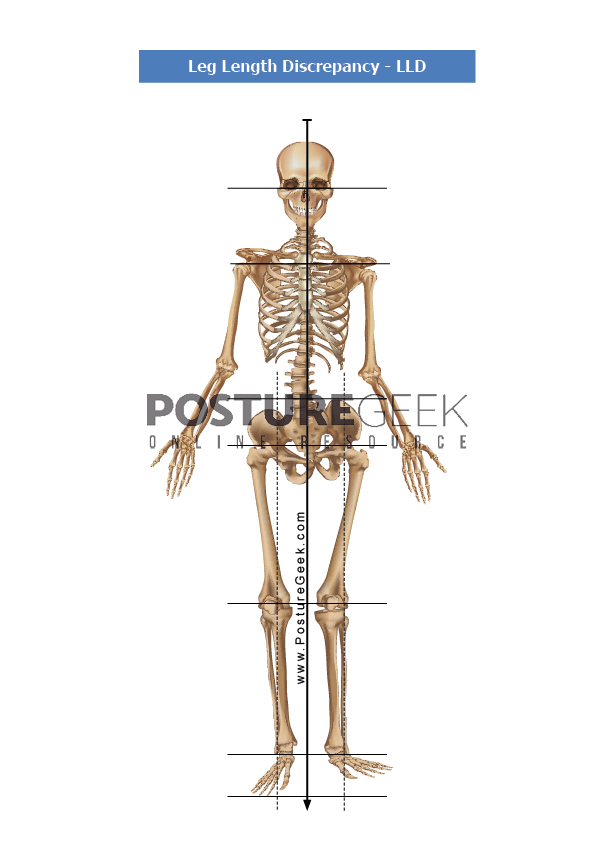Leg Length Discrepancy: Features and Characteristics
Leg Length Discrepancy (LLD) is a condition in which there is a difference between leg lengths. LLD can be congenital or acquired later in life. Leg length discrepancy often affects one side of the body more than the other. It may cause pain and gait irregularities such as limping, shortened stride, and patellar (knee) hypermobility.
The following is a breakdown of some of the literature that unpacks Leg Length Discrepancy. Use this information more as a starting point on your journey to further unpack any issues you may incur.
Understanding the implications of Leg Length Discrepancy on movement patterns can assist in managing your condition.
Posture Geek Tweet

The Long Leg Side (LLS)
OFTEN THE LEFT SIDE
Drooping shoulder with an elevation of Iliac Crest (Pelvis).
Decrease Sacral Angle and increase scoliosis:
- As the pelvis moves away from balance and symmetry, it creates upward changes via the spine (attached to the pelvis).
Pelvic obliquity – an upward tilt on a coronal plane:
- The hip appears to hike or lift upwards on the same side as the longer limb.
- Pelvic Torsion
Hip pain – longer leg more likely.
Increase pressure due to decrease contact of the femoral head with the Acetabulum. The more significant the LLD, the decrease in contact area:
- The hip joint is basically the ‘ball’ like end of the thigh bone (femoral head) sitting within a cup-like bowl (Acetabulum of the pelvis). If the leg doesn’t rest appropriately within the Acetabulum, then undue pressure and strain are placed within the joint.
- Deep abdominal muscle grouping that plays an essential role in supporting our posture.
Tight Piriformis muscle:
- This may lead to possible sciatic problems.
Posterior rotation of Innominate (left side of the pelvis) can shorten limb:
- In trying to shorten the longer leg, the pelvis may try to tuck under or tip back.
The Quadriceps muscle group is more likely to be active:
- The muscles in the front of the thigh may be working more. The longest of these is the Rectus Femoris which interestingly is a hip flexor, just as is the Psoas muscle.
Hip and knee flexion in the sagittal plane:
- The hip and knee may bend slightly to lessen the difference in length between the two legs and balance the pelvis.
Knee flexion puts strain on knee extensor mechanism:
- By constantly trying to bend the knee, the muscles on the back of the leg may begin to strain as they are repeatedly placed in a shortened state.
The more significant the Leg Length Discrepancy, the greater the knee flexion:
- The longer the difference in leg length, the more pronounced the knee bending will be.
Medial knee-joint degeneration:
- Because the Leg Length Discrepancy makes the pelvis move from left to right, undue strain and wear will be felt on the inside line of the knee.
Dorsiflexion at Ankle (foot and toes pointing up):
- Just as the hip and knee bend to decrease the longer leg length, the Ankle will also do the same. This may also be a natural result of the hip and knee bending.
- The foot may flatten out more than the opposite leg, creating a lower inner arch.
May Try – Pelvis may correct obliquely by tilting away from long leg side:
- In trying to fix the imbalance, the pelvis may move away from the longer leg side.
The Short Leg Side (SLS)
Lumbar Spine convex to the short side with subsequent axial rotation:
- The spine usually pushes out to the right and rotates towards the same side.
Anterior innominate can lengthen limb:
- Often the right side of the pelvis will try to roll forward to increase the length of the short limb, attempting to recreate balance and symmetry.
Hip and knee extension:
- The leg will exaggerate, straightening out to the point where it will appear slightly behind the left when seen from the side view.
Lateral knee-joint degeneration:
- Because the pelvis may shift across to the side of the shorter limb, poor function and undue forces may be placed on the outer aspect of the knee joint.
Plantar flexion of foot/ankle:
- The foot follows the hip and knee extension backward.
Supination of the foot:
- The arch of the foot increases.
Early heel rise:
- Because the lower extremity all the way to the pelvis is trying to extend its length, when walking, the heel will lift off the ground earlier than it would in a balanced body.
May Try: Anterior Innominate to lengthen short side:
- In an attempt to bring symmetry between the two (2) legs, the pelvis may try to rotate too far forward.
